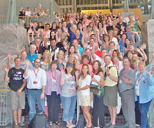 |
|
(cc) Photo by Anja C. Wagner |
I mentioned in my ISTE Reflection article that I thought 2012 would be the year that 3D printing and fab labs emerged as a major interest to the education world. But it’s more than just a cool technology that we’d like to see in schools. Personal fabrication may be hugely important to us.
A couple of weeks ago, I was having coffee with my friend, neighbor and fellow blogger, Paul Gilster (Centauri Dreams). A self-made authority on interstellar space exploration and associate with the Tau Zero Foundation, Gilster has inspired me for years, as expressed in the acknowledgments of all my books.
On that day, he told me about work toward sending small spacecraft to specific positions in space in relation to the sun. The craft would look back at our star and utilize the bending of light caused by the sun’s gravitational force to magnify what’s on the other side. The concept is called Gravitational Lensing, and was initially mentioned by physicist Orest Chwolson in 1924 and first quantified by Albert Einstein in 1936. In effect, we would be turning the sun into a gigantic lens, through which we would be able to see, according to Gilster, planets orbiting distant stars, continents on those worlds, and even cities, if they exist.
This is where my legs started to get wobbly.
Getting to specifics, Paul explained that to get a spacecraft to that position, about 750 astronomical units (AU) from the sun (Pluto orbits at an average of 40au), the craft would have to be very small and utilize nano scale mechanisms and even some degree of artificial intelligence.
At that point, a recurring question came to mind, which I asked,
“Assume that we’re approaching the limits of what we would practically want to do with our cell phones and personal computers, and that they’re about as small as we wish them to be, what’s going to drive further research and development in miniaturization – making things smaller? Surely not NASA.”
I didn’t actually speak the last sentence. But Gilster said that aside from the military, it would be personal fabrication, that we would all have our own in-house fabricators, where we would design and “print” our own cellphones, etc.
 As my son explained it to me, the lid that holds the batteries in our TV remote is broken and has been discarded. As a result, we have to handle the remote with care to prevent the batteries from falling out. Tape has not been a satisfactory solution. With a 3D printer, we would simply go to the Samsung web site, look up the part and print it. Ten minutes later (or an hour later, it doesn’t matter) the part would be sitting in our printer, where we could clip it into our remote. One of the 3D printers that I saw at ISTE cost only $1,600. The original Macintosh computers were nearly twice that expensive with only 128K of memory and no hard drive. 3D printers may become very important to us.
As my son explained it to me, the lid that holds the batteries in our TV remote is broken and has been discarded. As a result, we have to handle the remote with care to prevent the batteries from falling out. Tape has not been a satisfactory solution. With a 3D printer, we would simply go to the Samsung web site, look up the part and print it. Ten minutes later (or an hour later, it doesn’t matter) the part would be sitting in our printer, where we could clip it into our remote. One of the 3D printers that I saw at ISTE cost only $1,600. The original Macintosh computers were nearly twice that expensive with only 128K of memory and no hard drive. 3D printers may become very important to us.
The true potential is when we can design our own remotes, with our our own sense of flair, using design software, and then print in our own homes. Cottage industries might emerge, contests, DIY markets – and all fueled by creativity and inventiveness.
Check out the proliferation of Maker Faires and Cory Doctorow’s 2009 novel, Makers.
Now this idea of in-house fabrication and its cultural impact may seem a bit far-fetched to you. However, if you’re old enough, you may remember a time when carrying your personal phone in your pocket might have seemed just as unlikely – a phone with which you could get weather and news reports on demand, have access to an interconnected global library, pinpoint your exact location on a map and participate in any of a million global conversations.
My question is this. What should our children be learning today and how should they be learning it, to be ready to leverage this kind of creative opportunity?
What do you think?







